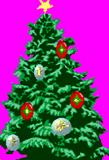1. CHRISTMAS
TREE
One of the most
popular and cherished Christmas customs is the "Christmas Tree",
earlier known as the "Christ Tree".
It is decorated with lights and ornaments, and set upright in
houses. It is considered a symbol and
reminder of salvation and forgiveness through Jesus Christ.[1]
In 1882, the world's
first electrically lighted Christmas tree was decorated in the

 But
when, where, and how did this custom begin? What is the origin of the Christmas
tree?
But
when, where, and how did this custom begin? What is the origin of the Christmas
tree?
Ancient Celebrations:
Trees have played an important role from ancient times in pagan religions, and were even worshipped. In pagan mythology, the evergreen tree was a symbol of the essence of life.
Norsemen (ancient Scandinavians), Celts (early people of
In Northern
Europe, the winter festivities were
considered to be a Feast of the Dead, focusing on the Norse god, Odin, and his night riders, with ceremonies full
of spirits and devils. One particular solstice festival was "Jol" (Yule), celebrated throughout
In the earlier
pagan customs, an evergreen tree was
decorated in honor of their god Adonis, who
after being slain was brought to life by the serpent Aesculapius[2]. The representation of the slain Adonis was a dead stump of a tree. In
Heathen people
in the
Christian Celebration:
Historically,
the custom of decorating Christmas Tree can only be
traced as far back as the 16th century,
and there are various legends concerning its origin. Some think that Martin Luther introduced the
Christmas tree. It is said that while
coming home one dark winter's night near Christmas, he was struck with the
beauty of the starlight shining through the branches of a small fir tree
outside his home. He duplicated the starlight by using candles attached to the
branches of his indoor Christmas tree. Some reports attribute the
origin of Christmas tree is to Wilfred of Crediton, an 8th Century missionary
who worked to save souls in pagan
However, there
is general scholarly consensus that the Christmas tree originated in
As far as we know, the first Christmas trees did not have lights; the first mention of lights (candles) on a Christmas tree is in the 17th century; these trees were decorated with paper roses, apples, Communion wafers, gold, foil, sweets, and dolls. The Christmas Tree slowly grew in popularity and use from the mid-seventeenth century onward. However, it was not until the beginning of the 19th century that the use of the Christmas tree grew considerably.
In
For many years the Christian church had banned the use of evergreens in the Christmas celebrations because of their history with paganism.
In the Old Testament, Jeremiah warned the people who decorated the trees:
Hear
ye the word which the Lord speaks unto you, O house of
2. CHRISTMAS EVE & YULE LOG
Another custom in the Christmas celebration
among some Christian groups is that on the Eve of Christmas, i.e., when the sun
goes down and darkness appears on 24th of December, the entire
family would pull in a large central trunk of a tree (– the Yule log) into the
house; it would then be placed in the fireplace and burnt.
Long before the advent of Christianity, the heathen Anglo-Saxons called the 25th of December "Yule day". "Yule" is a Chaldean (ancient Babylonian) word meaning "infant." So the "Yule day" means "infant day" or "child's day".
The night before "Yule day" was called "Mother night". This corresponds to the "Christmas Eve" of today. In the Babylonian mythology, Nimrod's wife, Semiramis, was the inspiration for "Mother night". "Child's day" was the supposed birthday of her son Tammuz. the log placed in the fireplace represented the dead Nimrod, and the tree which appeared the next morning was Nimrod alive again – reincarnated in his new son (the sun-god), Tammuz.
In
In
Only in 1577 did it become a public ceremony
in
The most common "Yule
log" today is the Yule Log cake which is made to look like a traditional
log.
3. CANDLES
Another custom in the
celebrations is to light a large candle on Christmas Eve, called the
"Christmas light", symbolizing Christ who is the light of the
world.
This tradition started sometime in the Middle Ages. In earlier days a candle was burnt at the same time as the Yule log.
In western
The Christmas candles which are kept burning from early dawn to the close of Christmas day are believed to ward off evil during the ensuing year. The tiny colored candles on the Christmas tree also have the same meaning, or probably these lights are simply a commercial idea invented and marketed by Edward Johnson in 1882 with his friend Thomas Edison. Then there were egg size globes of red, white and blue, and don't really have any Christian significance.
4. SANTA CLAUS
The significance of Santa Clause is also notable in the
Christmas celebration – the best-loved of all Christmas gift-givers. According
to popular belief, Santa Clause brings gifts and toys to all on this very day.
 Santa
Claus or "Father Christmas" is a plump white-bearded and red-suited
jolly old man who delivers presents to good children at Christmas time. The term, Santa, is another spelling
for saint, and Claus was a Dutch pronunciation of the last part of his
name, Cholas. Over the years, these interwoven legends of "Santa
Cholas" were handed down from one European generation to another. Santa Claus is a
corruption of the Dutch Sinter Klaas, or Sint Nikolaas. Santa
Claus was also known as "Kriss Kringle," a corruption of the
German "Christ Kindl" – Christ Child. Most cultures believe Santa Claus to be a
benevolent, fat and jolly character, often elvish in origin.
Santa
Claus or "Father Christmas" is a plump white-bearded and red-suited
jolly old man who delivers presents to good children at Christmas time. The term, Santa, is another spelling
for saint, and Claus was a Dutch pronunciation of the last part of his
name, Cholas. Over the years, these interwoven legends of "Santa
Cholas" were handed down from one European generation to another. Santa Claus is a
corruption of the Dutch Sinter Klaas, or Sint Nikolaas. Santa
Claus was also known as "Kriss Kringle," a corruption of the
German "Christ Kindl" – Christ Child. Most cultures believe Santa Claus to be a
benevolent, fat and jolly character, often elvish in origin.
In 16th century
It is reported that the
historical Nicholas was the bishop of
Some Christians believe that the Santa Claus concept came from the pagan Egyptian god, Bes, a rotund, gnome-like personage who was the patron of little children. Bes was said to live at the North Pole, working year-round to produce toys for children who had been good and obedient to their parents. The association of Santa Claus with snow, reindeer, and the North Pole suggests Scandinavian or Norse traditions of the Yuletide season.
Some are of the
opinion that the name Santa Claus originated way back in the time of Nimrod of
Babylon. In
Regardless of which origin of the name Santa Claus one chooses to believe, the concept of Santa Claus on a whole has been a subject of criticism in some Christian quarters. They regard him a counterfeit persona, becoming the undisputed spirit, symbol, and centerpiece of Christmas, which diverts attention away from the real central figure of Christmas – Christ. To tell children that Santa Claus is a man that lives in the north pole, rides a sled pulled by reindeer (one of which is called Rudolph who is known for his red nose), and that Santa is responsible for bringing all the presents that are received on Christmas day, being untrue. They say that when parents lie to their children about Santa Claus, they are taking the attention of their children away from God and causing them to focus on a fat man in a red suit with god-like qualities. All of this teaches the child to believe that, just like Santa, God can be pleased with "good works," done in order to earn His favor. Also, they teach that no matter how bad the child has been, he will still be rewarded by God – just as Santa never failed to bring gifts. Even in homes of professing Christians, Santa Claus seems to have displaced Jesus in the awareness and affections of children.
5. MISTLETOE
AND HOLLY


Christmas is incomplete to many unless it
involves “kissing under the mistletoe.”
It is believed that the blood-red berries symbolize Christ's bleeding death and his crown of thorns. The mistletoe symbolized the reconciliation between God and man. And since a ‘kiss’ is the well known symbol of reconciliation, that is how "kissing under the mistletoe" became a custom – both were tokens of reconciliation. The early church banned the use of mistletoe in Christmas celebrations because of its pagan origins. Instead, church fathers suggested the use of holly as an appropriate substitute for Christmas greenery. The Encyclopedia Americana states, “The holly, the mistletoe, the Yule log…are relics of pre-Christian time.”
Witches and other pagans regarded the red holly as a symbol of the menstrual blood of the queen of heaven, also known as Diana. The holly wood was used by witches to make wands. The custom of hanging Holly and Ivy was to pay homage to the spirits that would bring life and fertility into the home. The red berries on the holly was for man’s sexuality (the hanging of round balls on a tree represented the same), the ivy for a woman around him. The green leaves represented the man’s potency and the berries the life. In combination with the female ivy, it promised new life and fertility to the entire household for the year to come.
Two hundred years before the birth of Christ, the Druids (a cult of pagan Celtic priests who were considered magicians and wizards) used mistletoe (an evergreen plant that is parasitic upon other trees) to celebrate the coming of winter. They would gather this and used it to decorate their homes. They believed the plant had special healing powers for everything from female infertility to poison ingestion.
Druids considered mistletoe to
be a divine branch that had dropped from heaven and grew upon a tree on earth
(– compare with the Christian concept concerning Christ, "the Man the
Branch," coming from heaven). The mistletoe, being a sacred plant and a
symbol of fertility, was also believed to contain certain magical powers,
having been brought to earth from heaven by a mistle
thrush carrying it in its toes (hence the name). It was once known as the
"plant of peace," and in ancient
The white berries of mistletoe
were believed by pagans to represent droplets of the semen of the sun god. Both
holly and mistletoe were hung in doorways of temples and homes to invoke powers
of fertility in those who stood beneath and kissed, causing the spirits of the
god and goddess to enter them. If a husband
and wife wanted a child, they would go under it and it was supposed to bring
holiness and fertility. These customs
transcended the borders of
________________
Home - Quran & Hadith – Charity - Family & Health – Islam – Miscellaneous – Matrimonials
Human Rights - Women – Newscenter – Boycott – Chechnya – Palestine - Links